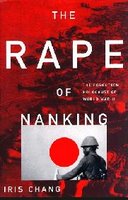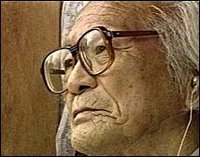
Home_____The Rape of Nanking
Because of a mutually convenient "gentleman's agreement" between Japan and the United States, little has been done to make the world aware of it, yet it stands as one of the greatest horrors in history. Be advised that what follows is not for the squeamish.
Between December 1937 and March 1938 a terrible massacre took place. Japanese troops captured the Chinese city of Nanking and embarked on a campaign of murder, rape and looting.
Based on estimates of historians and charity organizations, between 250,000 and 300,000 people were killed, many of them women and children. The number of women raped was put at 20,000 with many accounts of civilians being hacked to death.
Soldiers used prisoners for bayonet practice, which is well-documented. Women suffered most; rape is reported as embedded in the Japanese military. Thousands of females, as young as eight and as old as eighty, were raped and many were then murdered. One Japanese soldier stated, "no matter how young or old they could not all escape the fate of being raped... each was allocated to fifteen or twenty soldiers for sexual intercourse and abuse."
A Chinese man, named Tang, was captured and taken with hundreds to a pit in which sixty Chinese already lay. Tang recalls a soldiers' game with the living Chinese, a killing contest to see who could kill the most the fastest. Tang remembered a pregnant Chinese woman fighting for her life as a Japanese soldier dragged her away to rape her. No Japanese moved to help. Tang states, ". . . in the end the soldier killed her by ripping open her belly with his bayonet and jerking not only her intestines but a squirming fetus. . . ." Tang survived only by falling into the pit under a beheaded man.
Does the Japanese public and its government acknowledge and apologize for these horrors? No. The public shrugs, or speaks of tall tales. Many Japanese officials and historians deny that there was a massacre on such a scale. They admit deaths and rapes, but say the scale was much smaller. And in any case, they argue, these things happen in times of war.
 In his late eighties, Azuma Shiro recalled one episode: "There were about thirty seven old men, old women and children. We captured them and gathered them in a square. There was a woman holding a child on her right arm ... and another one on her left. We stabbed and killed them, all three--like potatoes in a skewer. I thought then, it's been only one month since I left home . . . and thirty days later I was killing people without remorse."
In his late eighties, Azuma Shiro recalled one episode: "There were about thirty seven old men, old women and children. We captured them and gathered them in a square. There was a woman holding a child on her right arm ... and another one on her left. We stabbed and killed them, all three--like potatoes in a skewer. I thought then, it's been only one month since I left home . . . and thirty days later I was killing people without remorse."Has his voice been heard? No. The official Japanese position is that their troops comported themselves no worse than other soldiers in combat. The only problem is that the Japanese were fighting nobody. The city had fallen. Chinese troops had fled, leaving civilians defenseless.
Having recently published a book on the Rape of Nanking, Azuma, appealed a Tokyo court decision ruling that his memoirs wrongly accused his former commander of atrocities in the city.
Azuma said this at news conference at the YMCA in Tsim Shai Tsui: "If the matter is allowed to rest . . . then obviously the massacre will be treated as fiction and the Japanese people will ignore this piece of history."
(The Japanese are notorious for selective amnesia about their own past. In public schools very little text book space is given to Japan's role in World War II, nor do students know Japan started it. A Japanese university professor tells of a student who hadn't learned that Japan and the United States had been at war. When he found out, he said, "Oh, really? Who won?")
A singular witness was John Rabe, a German Nazi and loyal supporter of Adolf Hitler (for the economic recovery of Germany). Leader of the Nanking International Safety Zone, Rabe was responsible for saving the lives of nearly three-hundred thousand Chinese men, women and children in the safety zone. He used his swastika arm band to good purpose, as he repeatedly shoved it under the noses of Japanese soldiers about to rape Chinese women.
Iris Chang has brought this holocaust to the attention of the world in her book, The Rape of Nanking.
